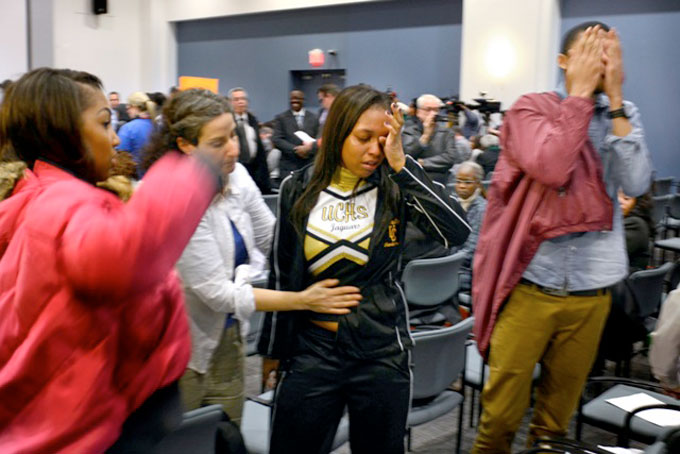
SAD DAY–Students and staff from University City High School react after their school was closed by the School Reform Commission in Philadelphia, March 7. (AP Photo/The Philadelphia Inquirer, Tom Gralish)
by Kathy Matheson
Associated Press Writer
PHILADELPHIA (AP) — When ninth-grader Zach Kaufmann found out his school was one of 27 targeted for closure in Philadelphia, he fought back.
He joined a youth activist group, attended numerous community gatherings and even addressed district leaders at a public meeting. But his passion for Carroll High School was no match for the district’s dire financial situation.
The School Reform Commission voted Thursday to shut Carroll and 22 other public schools at the end of this academic year. Four buildings were spared.
“I’ve really done a lot to show them how much I love Carroll,” Kaufmann said Friday. “I guess it didn’t really get through to them.”
Philadelphia has now joined a string of urban districts — including Pittsburgh, Detroit and Washington, D.C. — that have sought to offset huge enrollment drops and increasing maintenance costs through mass closings.
On Friday, parents, students and staff were coming to grips with the impending closures, which represent about 10 percent of the district’s schools. Many say the closings will irreparably damage dozens of neighborhoods and further fuel a student exodus from the district.
Timothy Stults, the principal at University City High School, said there was “a lot of turmoil” in the building Friday morning. Students had fought the closing for months, he said.
“They’re experiencing the grief process the way anybody else would,” he said. “It’s been a difficult time.”
Stults acknowledged that the building is nearly empty — 500 students in a space that can hold 2,000 — and needs about $33 million in renovations. But he said recent new programs have increased attendance and achievement, and that he, too, was struggling to accept the closure decision.
“Our kids have grown so much over the course of the last several years,” Stults said. “Frankly, I couldn’t be any prouder of our kids.”
Community members are concerned also by the potential for blight, combining students from rival areas in the same school, and longer walks for younger students, sometimes through dangerous neighborhoods.
Tina Hughes, parent of a pre-kindergarten student at Alexander Wilson Elementary School, said its planned closure will be a major inconvenience because the district won’t be providing transportation to her daughter’s new building.
“The school they’re trying to send her to is about, maybe, half-an-hour away from where I’m at right now,” she said.
Philadelphia’s 23 percent decrease in student population over the past decade is partly due to the explosive growth of charter schools, which are publicly financed but operate independently.
Supporters say charters offer innovative and sometimes safer alternatives to traditional schools, but critics say they drain resources from their district-operated counterparts without offering a better education. Charters now serve about 55,000 students in the city, up from 20,000 a decade ago.
Those numbers are a critical part of the story, said Mark Gleason, executive director of the Philadelphia School Partnership, a nonprofit that seeks to spur the expansion of all types of high-performing schools in the city.
“The real issue here isn’t school closings. The real issue is there aren’t enough good schools in Philadelphia,” Gleason said Friday. “The lack of good options is what’s causing parents to go elsewhere, which is what’s causing buildings to be empty.”
Gleason was among more than 30 people who addressed commissioners before the vote, and the sole person to support the closures. He read his testimony over a chorus of boos in an auditorium packed with hundreds of protesters.
Before the meeting started, 19 people were arrested on disorderly conduct charges — including American Federation of Teachers president Randi Weingarten — for trying to prevent commissioners from entering the room.
After it was over, commission Chairman Pedro Ramos said in a statement that the vote was difficult, but necessary. Officials had to borrow $300 million to make ends meet this year, and the district will run a nearly $1.4 billion deficit over five years without a radical overhaul.
“By not taking action now,” Ramos said, “we would continue the deterioration of our public schools to the point where they become obsolete to the children that we have sworn to serve.”
Follow Kathy Matheson at www.twitter.com/kmatheson